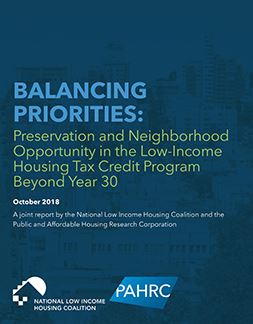The National Low Incoming Housing Coalition: Balancing Priorities
One of the most significant drivers of affordable housing development in U.S. history is the Low-Income Housing Tax Credit (LIHTC). It has spurred the creation or preservation of nearly 3 million affordable rental units since its inception in 1987. These homes, affordable to households earning below 50-60% of area median income, remain affordable for 30 years after they go into service. This means they provide steady, stable homes for vulnerable families.
But in the next decade, around a quarter of currently existing LIHTC units will reach the end of their affordability restriction periods. Many of these units are at risk of conversion to market-rate rents and many others need significant physical upgrades to prevent deterioration. Balancing Priorities, a report from the National Low-Income Housing Coalition, takes a look at these preservation challenges through the lens of neighborhood opportunity and desirability. The report examines neighborhood opportunity (specifically with regard to economic mobility) as well as desirability (defined by several factors including income and poverty, housing values, and crime) in the areas where this at-risk inventory is located.
The authors found that properties where rent restrictions are due to expire in the next decade are predominately located in low-desirability, low-opportunity neighborhoods (42% of at-risk units). Because rents are often lower in such places, it can be more challenging to cover the cost of necessary renovations to keep units habitable and affordable. About 15% of the units are in high- or very high-desirability neighborhoods where market pressures make it critically important to preserve affordability and prevent displacement.
With limited resources, how do housing practitioners balance the need to keep at-risk units affordable with the desire to increase mobility and help low-income families move to (or stay in) more desirable, higher-opportunity neighborhoods? Balancing Priorities offers suggestions for policymakers and practitioners, including practical ways to look at preservation and mobility as complementary, rather than competing, priorities.
